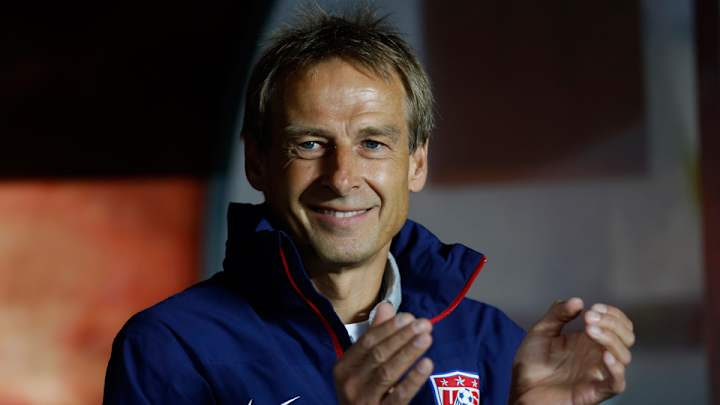Jurgen Klinsmann eyes full-strength USA, style growth for Oct. friendlies

United States head coach Jürgen Klinsmann wants to continue the momentum of a 1-0 win over the Czech Republic in Prague by calling in “the strongest squad possible” for two friendlies in October, he said in a Q&A on the U.S. Soccer website.
“We look at bringing the players back that won in the Czech Republic, and also to mix them with the players here in MLS,” Klinsmann said. “We can make our comparisons and see where they are at.”
The U.S. meets two 2014 World Cup squads in October, first taking on Ecuador in East Hartford, Connecticut – for Landon Donovan's USA farewell – before playing Honduras in Boca Raton, Florida. Normally, domestic friendly squads are dominated by Major League Soccer players – these two being in the midst of MLS playoff battles adds another layer of complication – but as the two matches fall on official FIFA fixture dates, European clubs would be compelled to release players to Klinsmann.
STRAUS: USA philosophy, not result, key in victory over Czechs
That leaves the door open for young players Emerson Hyndman, Rubio Rubin, Joe Gyau and Julian Green to receive another call-up.
“At the start of a new World Cup cycle, you always want to use that chance to introduce new players and give them the messages about what it takes to become a senior national team player,” Klinsmann said. “The base for all of that is their performance in their club teams. Emerson Hyndman is a starter at Fulham. Rubio Rubin is a starter at Utrecht. Julian Green moves to Hamburg, and we need him to play there. They play in European clubs and fight their way through at a very early age.”
Klinsmann has long preached the benefits of playing in Europe to the players in his pool, although he has also been supportive as some of the veterans have recently moved Stateside. Jermaine Jones said Klinsmann was a major driving force behind his transfer to the New England Revolution.
However, Klinsmann rewarded ambition with the squad he called up for the Czech Republic match, emphasizing that players’ desires to play outside their comfort zones would continue to turn his head.
“The young players that were part of the camp in Prague and won against the Czech Republic sent a very strong message out there to the more established players,” he said. “They sent a message of competition. … This is what you want to have as a national team coach. You want these youngsters coming in not being scared or afraid, taking risks and making some statements.”
WAHL: Three thoughts on the USA's 1-0 win over Czech Republic
The coaching these younger players receive abroad was also highlighted in the U.S.’s style of play in Prague. Klinsmann often speaks of playing a more proactive style, building out of the back and taking the game to the opponent.
From the older players before and during the 2014 World Cup, that ideal was difficult to see. The U.S. made its reputation in Brazil on a fighting spirit and mental toughness, not superior technical and tactical ability.
Against the Czechs, Klinsmann seemed to implement a new blueprint moving forward, asking his defensive players and goalkeepers to be comfortable on the ball and build through each third of the field to attack.
“It’s definitely a huge step for us to play out of the back, to find defenders and open up the game right away and not to play long balls all the time,” Klinsmann said. “Pretty much every long ball is a turn over. In the first half with Brad Guzan delivering those balls into [Mix] Diskerud, into the fullbacks, into the center backs, that looked really nice. Obviously for Nick Rimando, he’s used to doing that. He’s almost like a field player, and he’s very comfortable playing out of the back.”
MORE: Klinsmann sets semifinal goal for 2018 World Cup
At times, the lack of familiarity became apparent, and play broke down against a talented Czech Republic side that missed out on World Cup qualification after finishing third in a UEFA group containing Italy and Denmark.
It’s the start of a four-year process and Klinsmann’s second cycle. Implementing a possession style can’t happen overnight, but the younger American players are beginning to reap the rewards of a changing emphasis in the domestic youth game and early moves abroad.
“We told them not to worry about making mistakes,” he said. “Here and there, it might happen, but we want this game to be developed from the back into the midfield and then into the forwards and not to be forced always to play long balls.”
The next challenge will be to prevent Klinsmann’s words from becoming simple lip service. One match cannot make a lasting difference, especially a friendly.
The key will be continuing to build on a positive start in Prague and eventually attaining a level of comfort to allow the seeds of that possession style to grow into a vicious back-to-front attack in meaningful competitions such as the 2015 CONCACAF Gold Cup, the 2016 Copa América and Summer Olympics and eventually, the 2018 World Cup in Russia.
“This is something we are going to encourage more and more going forward. We want to keep the ball. We want to build out of the back,” Klinsmann said. “We want them to have the confidence to do that and not worry about mistakes. I think it was a big step forward, and we will emphasize that going into the October games as well.”
